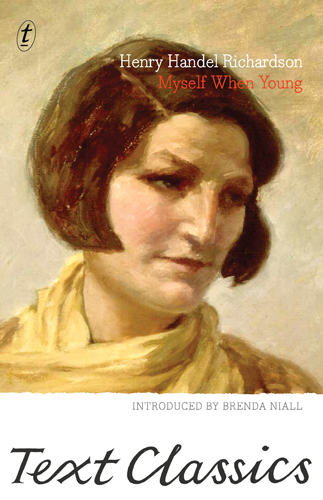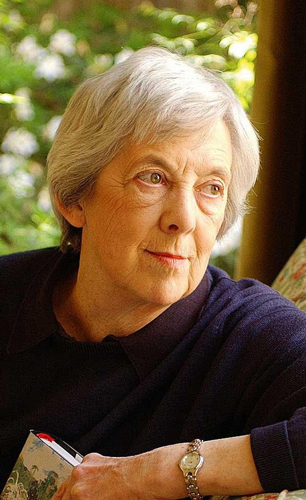Some memoirs are written in tranquil mood and quiet spaces. Not this one. When Henry Handel Richardson sat down at her desk in September 1942 to contemplate her younger self, the sound of German bombing raids made writing almost impossible. Yet she found the task a welcome escape from the turbulent present. A novel in progress and a short story were put aside. Myself When Young was her last book. Although she did not live to complete it, her memoir opens a door to her past that she had kept firmly closed during her life as a writer.
After her husband’s death in 1933, Richardson had moved from London to Sussex. Her house, Green Ridges, chosen for its seclusion and its spectacular views of sea and coastal cliffs, happened to be in the flight path of German bombers bound for London and other strategic targets. Night after night her house shook: the windows rattled and once or twice their glass shattered. In interludes of quietness Richardson began to write her reminiscences.
Richardson had always resisted questions about her younger self. Her identity as Australian-born Ethel Florence Lindesay Richardson, wife of London-based scholar John George Robertson, was concealed from the literary world under the pseudonym Henry Handel Richardson. ‘Mrs Robertson did not write my books’, she insisted.
The male pseudonym was partly a game she wanted to play. Would anyone suspect that her first novel, Maurice Guest (1908), was a woman’s work? She won that round; no one guessed that this powerful study of obsessive love, set among music students in Leipzig, had been written by a woman, let alone a young Australian newcomer to Europe. And although her next novel, The Getting of Wisdom (1910), came very close to her own experience at Melbourne boarding school Presbyterian Ladies’ College, the expatriate author’s identity remained a secret. The few friends who knew the truth respected Richardson’s fiercely maintained privacy. Those who were shocked by this candid account of the author’s schooling wanted her identity kept quiet. But the author’s hidden self couldn’t withstand the spectacular success, in 1929, of Ultima Thule, the final volume of the trilogy The Fortunes of Richard Mahony. The first two volumes, Australia Felix (1917) and The Way Home (1924), had been disappointingly received; and without a subsidy from her husband, Ultima Thule might not have come to light. When it eventually appeared, critics compared its tragic vision with the greatest European novels, especially those of Dostoevsky.
Even when she became a celebrity, with huge sales in the United States, Richardson revealed very little about herself. Reporters had to work with snippets, and they made conjectures that amused and annoyed the author. Having her name given as ‘Henrietta’ was a persistent irritant; her birth name of Ethel Florence Lindesay Richardson was equally unacceptable.
Being Henry was essential to Richardson’s sense of self. It was also her defence. She insisted that she needed a mask to hide behind, or a ‘straw man’ to take her place against attack. With half a lifetime of being called Henry, even by her husband, it would be hard to unmask for the public in a memoir. Why then, did she write Myself When Young? She had already confronted the ghosts of her past and turned them to fiction. Richard and Mary, in the Mahony trilogy are not her parents, Walter and Mary Richardson; nor is Laura in The Getting of Wisdom the author’s self. Yet the novels in which they appear could not have been written without much searching and questioning of herself, her family and the events that had shaped her. Having scrutinised her memories and turned them, often painfully, into great art, hadn’t she done enough?
One reason was clear. The fame she had won with Ultima Thule meant that, at some time, someone would write her biography. She would be an elusive subject for an American or English biographer. For an Australian, the task might seem easier. The obvious potential biographer was Nettie Palmer, Australia’s most influential literary critic of the time. Henry respected Nettie’s intelligence and admired her dedication. The two women had much in common. They had been to the same school in Melbourne; they had both studied in Germany; they were both formidable intellectuals. Fifteen years younger than Henry, Nettie was close enough to understand her subject and distant enough to judge.
Yet there was a catch. Nettie had two passions: her novelist husband, Vance Palmer, and her dedication to the advancement of Australian literature. Henry thought Vance’s novels were boring and stodgy, and she did not want her own work to be defined by its Australian-ness. And there were some old grievances. Before the immense success of Ultima Thule, Nettie had written patronisingly about the ‘faded charm’ of the second volume of the Mahony trilogy. She had missed the point of The Getting of Wisdom, dismissing it as a conventional school story rather than a portrait of an artist in the making. She had no sense of humour, Henry concluded. ‘Nettie Palmer! What on earth could she know of my younger self?’ she wrote after Nettie had approached her about a biography (19 January 1943). The only way to ward off Nettie – and presumably others – was to write her own story.
‘When I do take pen in hand to write about myself & my work I shall always speak the blunt truth’, Henry wrote in 1941. ‘I can’t afford to go about nursing other people’s feelings.’(10 June 1941)
So she began to write Myself When Young. The first part was easy. I am ‘prancing forward with the Reminiscences’, she wrote in a letter to a friend. She found it intriguing to analyse the ‘particular small child that was me.’(19 November 1942) Her idea of biography was ‘absolute truthfulness: no bouquets, no touching up’(19 November 1942). That had to be her approach to her own history.
Although there are lapses from the ‘absolute truth’, so far as anyone can know it, Myself When Young reconstructs her past without self-serving evasions. She characterises herself as a difficult child, jealous of her pretty younger sister, Lilian, not much liked at school, and irritable with her mother, whose strength and generosity she nevertheless acknowledges.
The dominant fact of her early life was her father’s physical and mental breakdown. Intellectually gifted, at first successful as a medical practitioner and for a time a lucky investor in Victoria’s golden age, Walter Richardson’s illness left his family unprovided for. Henry remembered him as a ‘poor broken creature’ whose public episodes of dementia were an embarrassment to her nine-year-old self. When he was declared insane, and confined in the public mental asylum in Melbourne, it was more than his wife could bear. She petitioned for his release and brought him home to die. For his daughter, his death came as a relief; it was many years before she read his letters and understood his suffering.
Mary Richardson worked as a postmistress in Victorian country towns so as to educate her two daughters: Ethel (then known as Ettie) and Lilian. Ettie and Lil were musically gifted. When the family fortunes improved, Mary Richardson took them to Leipzig, so that Ettie could train as a concert pianist. But that dream collapsed. As told in Myself When Young, Ettie could not bear the scrutiny of an audience’s gaze, but it also seems likely that, as biographers suggest, she lacked the exceptional quality that makes a concert pianist.
The final section of Richardson’s memoir traced a happy time as a music student in Leipzig, where she met her future husband. John George Robertson, a scholarly Scot, became mentor and friend as well as devoted husband to the gifted, emotionally fragile Richardson. The relief with which she found herself ‘safely and soundly married’ resounds on the last pages of Myself When Young.
From September 1942 until her death in March 1946, Richardson worked on her memoirs. She persisted in spite of the threats and distractions of war, blackouts, rationing of food and petrol, recurrent ill health, as well as loneliness and the knowledge that all her books were out of print and likely to be forgotten. Advanced colon cancer was diagnosed in November 1944, and emergency surgery gave only a short respite. She returned to her memoirs, often in acute pain, writing a little at a time, stoically uncomplaining.
Richardson was able to die at home because of the loving care and companionship of Olga Roncoroni, a young amateur pianist, for whose acute, disabling anxiety Henry had taken immense trouble to arrange treatment. Olga came to the Richardson household in distress and stayed for many years to become its strength. Without Olga, ‘a jewel of a girl’, as Richardson described her, the memoir would never have been written. It closes with Olga’s postscript recording the courage with which Henry Handel Richardson met her death at the age of seventy-six, leaving the memoir unfinished yet unforgettable in its self-awareness, its wry comedy and its candid recall of her Australian childhood.
Works Cited
Clive Probyn and Bruce Steele (eds), Henry Handel Richardson: The Letters, Miegunyah Press, Melbourne, 2000.
This is Brenda Niall’s introduction to the Text Classics edition of Myself When Young by Henry Handel Richardson.






